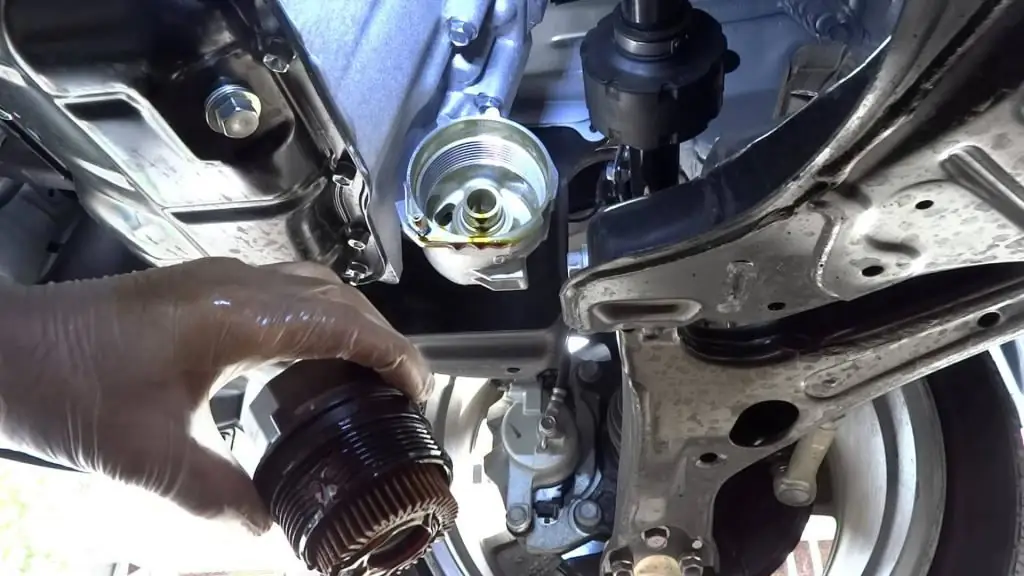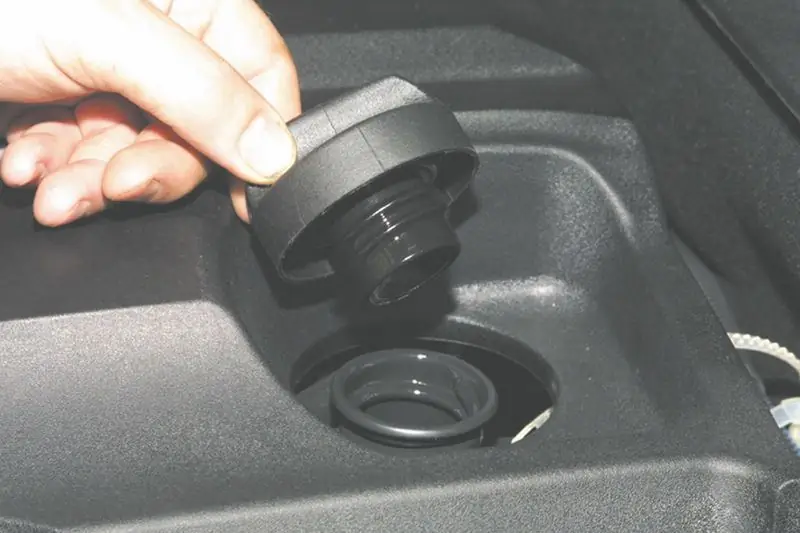2026 Author: Erin Ralphs | [email protected]. Last modified: 2025-01-22 21:14:16
Transmission lubricating fluids are used in gearboxes, transfer cases, axles and steering mechanisms. There are many cars where the same engine oil is poured into the gearboxes. But in some mechanisms that are subjected to particularly heavy and complex loads, and where it is difficult for oil drops and mist to get from it, a transmission oil supply under pressure is required.

Separate different groups and types of motor fluid. Gear oil classification also varies.
Accepted Classifications
One of the international classifications is the division by viscosity. This classification of gear oils is called SAE. In it, lubricants are divided into seven classes, four of which are winter (indicated by the letter W), and threethe rest are summer. All-season marking involves a double designation, for example, 80W90, 75W140 and others.
Another classification of gear oil, called the API, involves the division into six groups. They are used depending on the purpose, which is why they provide their own type of gear, specific loads and temperature.
Classification of gear oils according to SAE in general
This classification was developed by the American Society of Engineers. She became widely known. Many motorists know her better than any other.

The viscosity grade of the lubricant can be found in the owner's manual for each vehicle.
The choice of what this classification of gear oils offers is based on the temperature indicators of the environment where the car will be operated. Viscosity properties are determined in relation to the achievement of 150 thousand cP according to Brookfield. If this value is exceeded, the gear shaft bearings will begin the process of destruction. To prevent this from happening, you should strictly follow the recommendations for low temperature data, choosing the right lubricant.

If the car is planned to be operated at a temperature of about minus thirty degrees and below, then hydrocracking or synthetic lubricants, as well as semi-synthetics of viscosity 75W-XX with a viscosity limit of 5000 cP.
Hightemperature is determined at 100 degrees. Upon reaching it, the parts should not begin to break down, even if you have to be under such influence for 20 hours or more.
Classification of gear oils by viscosity: details
Here, just like in motor vehicles, lubricating fluids are divided according to seasonality:
- winter - 70W, 75W, 80W, 85W;
- summer - 80, 85, 90, 140, 250.

In this classification, such a division is conditional, since different manufacturers have their own design features.
But the SAE J306 standard, for example, has requirements that transmission fluids must meet. Thus, they must contain a single degree of the winter or summer series, or a combination of both degrees. There can't be two winter degrees at once.
In addition, while motor lubricants are indicated in the range from 0 to 60, transmission lubricants range from 70 to 250.
So the developers tried to prevent possible mistakes when choosing oil. Thus, if engine and transmission fluids have the same viscosity, then according to SAE their values \u200b\u200bwill be different.
API in general
A universal classification of gear oils for all types, alas, has not yet been created. But the API class for manual transmissions is the most convenient way to classify lubricants.
For it, cars use oils of the GL-4 or GL-5 group. GL-4 is suitable for mechanics and gearboxes hypoid orspiral-conical pairs and is used in moderate climatic conditions. And GL-5, in addition to moderate, can also be used in harsh conditions on different types of gears.
Separate API groups

Let's take a closer look at all the groups represented by the API gear oil classification.
Group GL-1 belongs to mineral lubricants. There are no additives in these oils other than those with antioxidant and antifoam properties.
GL-2 refers to oils with anti-friction additives that are used for worm gears with low rotating speeds.
GL-3 are greases that already have a lot of the additives they belong to and have wear resistant properties. They are used in gearboxes with several steps and for steering, in main and hypoid gears. Helical bevel gear pairs work with oil, designed for operation at low speeds and not in harsh conditions.

Group GL-4 has a high percentage of additives. These include those that have anti-seize properties. They are mainly used in cars with conventional gearboxes. The lubricant is able to function properly in transmissions where there are high speed rotations and low torques or vice versa.
GL-5 is a lubricant that can operate in difficult conditions, where you need to make a lot of effort and overcome heavy loads. Such oils are used on various models of cars and motorcycles. Applicable for hypoid gears, pairs of gears working with impacts. Lubricants contain a large amount of additives based on phosphorus sulphurous elements and reduce the likelihood of metal scuffing.
GL-6 oils provide good performance even under harsh operating conditions. They effectively withstand rotational speed, high torques and shock loads. They are characterized by the presence of the largest amount of extreme pressure additives in comparison with other groups. But oils in this group are not often used.
The majority of gear oils are mineral based. Synthetics are used very rarely.
Other classifications
CAE and API gear oil classification is the most common. But there are other divisions as well. For example, lubricants for automatic gearboxes belong to a separate category. They are not covered by the API as a gear oil classification. Zik, Total, Mobil and other manufacturers are guided by their own indicators in the manufacture of lubricating fluids.

ATF classification
Automatic oils are often painted in a bright color so that the motorist does not confuse and fill it in the manual transmission. Mixing of multi-colored liquids is also not allowed, Classification for automatic transmission, which would be as unified as for manual transmission, they do not. Therefore, manufacturers themselves deal with this issue. So, in General Motors they useDexron classification, and Ford - Mercon.
ZF classification
The classification of Zahnradfabrik Friedrichshafen, or ZF for short, is becoming widely known. It is the leader among European manufacturers of gearboxes and power units. Having developed its own classification, the company offers to focus on their classes in terms of quality and viscosity.
Each gearbox has its own oils. The division provides both an alphabetic code and a numeric one.
What to base your choice on
Classification of gear oils according to API, SAE and so on greatly facilitates the choice. But, when purchasing a lubricating fluid, you should also understand what tasks it should solve. Among them stand out:
- preventing too much friction and increased wear on gear surfaces or other transmission components;
- energy expended due to making film must be reduced;
- creating heat dissipation;
- stopping or minimizing the oxidation process;
- no adverse effect on the reaction of transmission parts on the surface;
- not reacting with water;
- preservation of original properties during long-term storage;
- reduce noise and vibration during transmission operation;
- No toxic fumes when heated.
Properly selected gear oil will successfully solve its problems and help extend the life of mechanisms.
Recommended:
API SL CF: decryption. Classification of motor oils. Recommended engine oil

Today, almost any driver who has a we alth of experience behind him knows perfectly well what the decoding of the API SL CF testifies to. This applies directly to engine oils, and among them there are different options - for diesel and gasoline engines, including universal oils. Beginners can simply get confused in this combination of letters and sometimes numbers
Changing the oil in a Mercedes. Types of oil, why it needs to be changed and the main task of engine oil

A car is a modern vehicle that needs to be monitored every day. A Mercedes car is no exception. Such a machine should always be in order. Changing the oil in a Mercedes is an important procedure for a vehicle. In this article we will talk about how important it is to carry out this procedure, what types and types of oil are
API specifications. Specification and classification of motor oils according to API

API specifications are developed by the American Petroleum Institute. The first API motor oil specifications were published in 1924. This institute is a national non-governmental organization in the United States
Oil change in Toyota: types and choice of oil, specifications, dosage, do-it-yourself oil change instructions

The reliability of your car depends on quality maintenance. To avoid additional repair costs, it is recommended to use engine oil in a timely and correct manner. The operation of any car implies a number of regulatory requirements. Toyota oil change must be carried out according to the instruction manual. It is recommended to perform the procedure after every 10,000-15,000 km of the vehicle run
Changing the oil in the Chevrolet Niva engine: the choice of oil, the frequency and timing of oil changes, tips from car owners

The car's powertrain needs regular maintenance. The engine is the heart of any car, and its service life depends on how carefully the driver treats it. In this article we will talk about how to change the oil in a Chevrolet Niva engine. Despite the fact that every motorist can do this, there are some nuances that you must first familiarize yourself with

